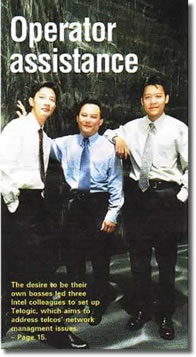|
ComputerWorld
2002
This Article first appeared in 19-25 April 2002
COMPUTERWORLD
  | |
ComputerWorld, Apr 19, 2002--When
three colleagues in Intel saw the opportunity to address what they called a "problem
statement" in the telecom industry, they decided to pursue their dreams that
resulted in the founding of Telogic, a telecommunication solutions provider. "We
all share the same ambition to be our own bosses," said Alex Tok, one of
Telogic's three cofounders and also the company's business development director.
"The entrepreneurial spirit was kicking within us, and since we had this opportunity,
we grabbed it. The "opportunity" was the fact that in the course of
meeting up with various service operators, the founders noticed that these telcos
needed to better understand their network performance, and needed access to real
time data. "All these were lacking in their current systems," said Low
Kim Seng, another cofounder and sales director for Telogic. "Sure, there
were other available solutions around, but they tended to be more expensive and
less flexible." As a result, Low, Tok and Ang See Lin, the third cofounder
and also the company's technical director, decided to build their own solution
which would provide better value ? be cost effective as well as have a better
understanding of Asia Pacific requirements. "While there were western players
like Agilent, there was no local entity that could customize the solution according
to local needs," said Low. Product
fruition
After about three years of non-commercial development, the
effort has culminated in UniSS7, a telecommunications network management system,
which they have since commercialized after incorporating the company in January
this year. UniSS7 comprises a signaling monitoring system that allows extraction
of valuable realtime information from wireline or wireless networks based on
Signaling System 7 (SS7). SS7 is the signaling protocol used in the public switched
telephone network for communications between network points. By using non-intrusive
probes, UniSS7 allows the user to capture and analyze all messages flowing on
the SS7 network. Service providers can then extract and exploit the relevant information
to improve the efficiency of their networks, boost profitability, and increase
customer satisfaction. "There are various modules like quality of service
and service level agreement to measure performance between network points,"
said Tok. According to Telogic, the information gleaned is suitable for use in
a variety of applications like traffic engineering, network planning, interconnections
arbitration, fraud management, location based services, and even roaming services.
However, developing UniSS7 was not without its challenges. With the high cost
of personnel in Singapore, the founders decided to outsource coding to Thailand
and Indonesia in order to keep costs down. "While many think that India is
the place to go to for offshore software development, you will be surprised how
good programmers in Thailand and Indonesia are," said Low. "Only the
specification and design was done in Singapore." Test
drive
Another huge challenge was testing the product. "We don't
get access to networks all the time," said Tok. "We capture the trace
whenever possible and work closely with the telcos which believe in us. One such
telco was PT Indosat, an Indonesian operator that is currently using UniSS7. Telogic
also original equipment manufactures (OEMs) its software through Unified Communications,
which does network performance management. Telogic's other products include a
USSD gateway and a Location Based Services Gateway both of which are designed
to help operators address their network management issues as well as providing
enhanced services. "Moving forward, we aim to build Product fruition
After about three years of non-commercial development, the effort has culminated
in UniSS7, a telecommunications network management system, which they have since
commercialized after incorporating the company in January this year. UniSS7 comprises
a signaling monitoring system that allows extraction of valuable realtime information
from wireline or wireless networks based on Signaling System 7 (SS7). SS7 is the
signaling protocol used in the public switched telephone network for communications
between network points. By using non/intrusive probes, UniSS7 allows the user
to capture and analyze all messages flowing on the SS7 network. Service providers
can then extract and exploit the relevant information to improve the efficiency
of their networks, boost profitability, and increase customer satisfaction.
 |